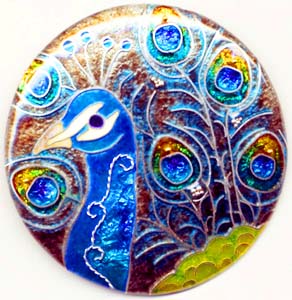 Enamel vs Resin (Cold Plastic Enamel): Enamel vs Resin (Cold Plastic Enamel):
how to tell the difference
Buttons come in many different materials with many decorative finishes (DFs). Both enamel (actually Vitreous Enamel) and resin (called in the Blue Book - Cold Plastic Enamel - CPE) are two such DFs. These can look very similar, but are vastly different in composition and how to create art using them. First let me give you some background...
- Resin is a form of plastic and is needed to be set in a kiln, however it can be low-heat set for faster drying. It is applied in various ways (brush, toothpick, etc) and usually only needs 1 or 2 applications. It air dries to cure. These come in both transparent and opaque colors. I have also heard it called Cold enamel or Unfired enamel or, as in the Blue Book, Cold plastic enamel (CPE). It is NOT enamel.
- Vitreous enamel is glass fused to metal at high temperatures. It is typically fired in a kiln between 1300°F and 1650°F. In my buttons, I fire at about 1450°F for copper designs and 1500°F for silver designs. But decals I fire between 1350°F and 1450°F, depending on the manufacturer. And if I do scrolling (a technique that Lowenstein did on some of his buttons, I fire at 1650°F. Some of my copper button designs might only take 3-5 firings, but my large silver cloisonne designs take 11-20 firings. And Diane Almeyda's plique-a-jour buttons are fired 30 times or more.
Enamelists really do not like resin being called cold plastic enamel as this is done to make the material sound more important than it is. Now don't get me wrong - some resin buttons are quite beautiful, but the same design done in enamel would be much more expensive, given the time that goes into the piece.
So, how can you tell the difference. There are two basic ways, one is a definitive test, the other is an eyeball test, but this only works if the resin is swirled.
- Definitive test: Use a straight pin - hold it vertically and tap the surface. If it skips over the surface, it's enamel (ie, glass), if the surface is tacky, it's resin. BUT be careful - you can scratch resin with a pin, but you cannot scratch enamel with a pin. Note: I have done this numerous times and have never scratched the resin, but it could happen so you need to be careful.
- Eyeball test: Look at the color and see if it's swirled. If so, note the type of swirl. Swirls in resin are smooth lines, but swirls done in enamel are usually done from lumps so the lines are surrounded by broader color (remains of the lumps). Liquid enamel can also be done with swirls, but again the look is different. it may take time for someone to know the difference and again, the pin test is definitive!
For your information, swirling in enamel is done with a technique called scrolling. It requires a thick base layer of enamel with lumps put on top and fired at 1650°F to get the enamel very very molten. At the right time, the kiln door is opened and the enamelist uses a pick to pull the enamel and lumps into a design. Of course the pick is long handled and the enamelist wears fire proof gloves as it is really hot when the door is opened.
Resin swirled
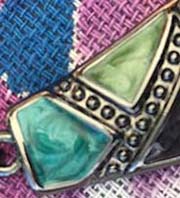
This shows resin that has been swirled in two areas. Note how different it looks, even with the fact that the Lowenstien button has more colors swirled than this.
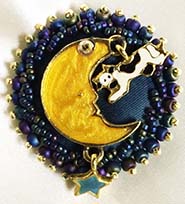
Here is one of my Studio Buttons which has resin in both the moon and the cow. The cow is solid so it would be hard to tell if it was enamel without using a pin, but the moon has the swirl look. Note that it doens't look like the scrolled enamel swirling. |
Lump Enamel Scrolled
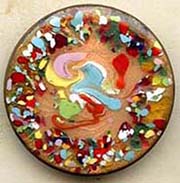
Lowenstein button - enamel button whose center has been scrolled. See the lumps around the edges that are still in "lump" form. But the ones in the center has been scrolled in the kiln.
|
Liquid Enamel Swirled
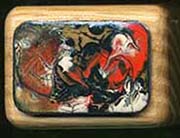
This is a liquid enamel design that has been swirled. Unlike the lump form of scrolling enamel, this swirling of liquid enamel is done before the liquid dries and thus before it is fired. It also has a different look than the resin swirls, but looks more like the enamel scrolling technique. |
|